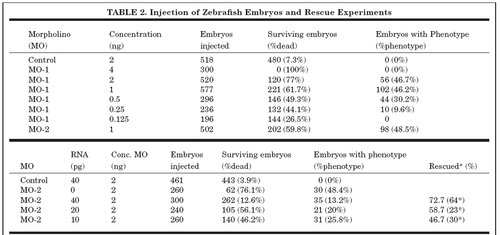
aThe asterisks indicate percentage of rescued embryos not including mortality as an aspect of rescue.
Microinjections of gene-specific enigma morpholinos and rescue experiments. (Upper panel) MOs were injected into the yolk of 1-cell stage embryos at the indicated final concentrations. Embryos were investigated for survival and survivors were classified as phenotype or non-phenotype at 24 hpf. Examples of the phenotype with a reduced tail and deformed somites induced by enigma knock down are given in figure 8. Numbers are embryos combined from three independent experiments. Embros were also checked for survival at the tail bud stage but no significant number of dead embryos compared to the control injections was observed in any of the experiments at this stage. (Lower panel) Rescue experiments were performed by co-microinjection of different concentrations of RNA (10, 20, and 40 ng) encoding a full length form of enigma along with the morpholino. Embryos were investigated for survival and survivors were classified as phenotype or non-phenotype at 24 hpf. The percentage of rescued embryos in the far right column refers only to surviving embryos and does not include dead embryos. In brackets marked with an asterisk are the percentages of rescue including dead embryos. Numbers of embryos injected with MO-2 alone were used as 100%. There are significant higher numbers of surviving embryos with the highest amount of co-injected RNA (40 pg).
|

